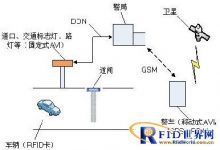
Solution of automatic vehicle identification and anti-theft system based on active RFID technology
[ad_1]
Challenges and needs
With the rapid development of my country’s economy and transportation, the total number of vehicles in my country has exceeded 60 million at this stage, and it is growing at an annual rate of more than 10%. With the increase in vehicles, violations such as evading annual inspections, embezzling license plates, using fake license plates, and modifying stolen vehicles are increasing; with the continuous improvement of people’s living standards, the number of urban taxis has soared, and a few car owners refuse to operate. Licenses, or apply for low-cost operating licenses in surrounding small towns to carry passengers to large cities. This type of taxi (commonly known as “black car”) infringes on the interests of the country and the industry; with the deepening of my country’s reform and opening up and its accession to the WTO, large-scale international and domestic conferences, and cultural and sports exchanges have become more frequent. Intrusions, disputes and even criminal cases of public security have occurred from time to time; vehicle theft in some local areas is extremely serious and has threatened the harmony and stability of the area.
In the past, the vehicle management department mainly relied on the establishment of cards and spot checks, temporary additional police and personnel on duty to manage the above-mentioned violations. Obviously, the efficiency of this method is extremely low, and on-site verification is very difficult. The phenomenon of denial of drivers and passengers is not uncommon. In terms of solving vehicle theft prevention, GPS was also a relatively extensive technology choice. GPS anti-theft is an active network system and a large system. The service personnel of the monitoring center provide car owners with 24/7 uninterrupted services, including alarming, preparation before the police and assisting the police. But at present it is not very popular, the main reason is that the price is too high. It costs six to seven thousand yuan to install a set of GPS without a display screen, and a service fee of nearly one thousand yuan is paid to the service provider every year. The high cost discourages many car owners. Especially for taxi owners who have been severely stolen and robbed, few people are willing to equip GPS anti-theft systems with expensive equipment and services, if it is not particularly mandatory. In this case, RFID technology can be combined to achieve the goal of reducing costs.
At present, the society is increasingly inclined to adopt the automatic vehicle identification (AVI) system based on active RFID technology. The AVI system can be installed at the city entrance and exit to form an AVI fixed base station or installed on a police car to form an AVI system mobile station. The mobile AVI system is one of the practical and effective means to solve the above problems. It can be parked at the entrance of the designated venue, or on the side of the road, or at the checkpoint, or toll station according to the needs; it can accurately and reliably collect data from it in real time. The data information of the vehicles passing by (or parked) and equipped with active proximity cards are identified and processed using remote radio frequency identification (RFID) technology, and the information is passed through the communication network (GSM/GPRS) /CDMA) transfer to the vehicle management center computer, compare with the information about the vehicle stored in its database, determine whether the vehicle is illegal or stolen, and return the comparison judgment results and instructions to the AVI system in real time to determine Deal with the car. The comparison judgment result and vehicle-related information can be printed out. For illegal vehicles that have been blacklisted, they can be reported to the police and intercepted on the spot, or the checkpoint in front of the dealership can be notified to intercept them through communication equipment.
application solution
1. Automatic Vehicle Identification (AVI) based on active RFID technology, including vehicle radio frequency tags, fixed base station AVI system and mobile base station AVI system.
1. Car radio frequency tags
There are vehicle information, vehicle status, and vehicle owner information on the on-board radio frequency tag. This radio frequency tag has a unique identification number (ID Code) in the world, and the identification number and its information are stored in the information exchange network of the public security department. Generally, it is in a static state of alert until the car is stolen or the owner requests traffic. Information inquiry is started. This identification number can help the police identify and track stolen vehicles. Car radio frequency tags should be installed firmly, reliably, and as concealed as possible without affecting normal operation. A special installation method can be used, so that once the label is removed, the alarm service can be automatically activated to prevent the label from being misappropriated.
2. Fixed base station AVI system
Using active microwave tags, the reading distance can reach 2 to 80 meters. The fixed base station AVI system is generally used for customs, checkpoints and toll stations on major traffic lanes to inspect, identify and record passing vehicles. Equipment (such as readers, smart controllers, data transmission units, power supplies, etc.) are installed beside the lane In the computer room.
When a vehicle carrying an RFID tag passes through the lane, the system reads the ID identification number in the tag, superimposes the passing time and lane number, and stores it in the memory of the intelligent controller. The data transmission unit transmits the vehicle data information collected by the system to the management center (or computing center) of the public security and transportation departments through the communication network (such as DDN), and at the same time, the control command of the management center is sent to the AVI system to determine the automatic control of the vehicle. Release or intercept.
3. Mobile base station AVI system
In some applications, such as public security criminal investigation, road inspection, and important meeting security, it is necessary to be equipped with a mobile AVI system, which can be started and parked at the designated roadside (or entrance of the venue) at any time to conduct surprise inspections and identification of passing vehicles. Its equipment configuration is similar to that of the AVI system fixed base station, but it is more simplified. The mobile AVI system can be installed on a modified police car, and use a mobile phone to send short messages (or other methods) through the mobile communication network (GSM) to maintain communication with the command center or exchange data. If you need to report the location of the mobile AVI system, the car can also be equipped with a GPS receiver to send a short message via GSM to transmit the location of the mobile station to the command center.
4. Simple mobile inspection equipment
In some applications, simple mobile inspection equipment (PDA handheld reader) can also be used. Inspectors can use PDA readers to check passing vehicles in certain narrow areas. The PDA reader has downloaded the stolen vehicle information (blacklist) in advance, and once the same information is read, it will immediately call the police.
2. Anti-theft network based on AVI and GPS
This system is composed of fixed AVI, mobile AVI, GPS positioning and navigation system, DDN data transmission and exchange system and GSM mobile communication system. The schematic diagram is shown in Figure 1.

Figure 1 Schematic diagram of anti-theft system
When the user using this technology determines that the vehicle is stolen, they will report to the police. After receiving the alarm, the police will issue instructions for each fixed AVI to detect passing vehicles, read the RFID tags of the passing vehicles, and then communicate with the target vehicle information. compare. If the current vehicle is the target vehicle, the vehicle ID, the fixed AVI location, and time information are sent to the police via DDN.
After the police received the signal, they sent text SMS messages via GSM to the police car equipped with mobile AVI and GPS. After confirmation, the police car found the best route through GPS positioning and navigation system, and repeated the message several times. Confirm and optimize the route, and continuously send its GPS location to other guard vehicles, and finally work together to intercept the stolen vehicle, and arrest the criminals. The entire process of recovering the stolen vehicle is shown in Figure 2.

Figure 2 Schematic diagram of the process of recovering the anti-theft vehicle
In addition to the anti-theft function, for vehicles equipped with a GPS system, the system can also add road and vehicle location query functions.
On the premise of ensuring the anti-theft, the system adopts RFID technology to effectively reduce the cost, which can be accepted by most people, saves police force and improves the response speed, especially in the taxi industry with the characteristics of large-scale promotion. At the same time, the system is combined with the ETC system, the equipment (logistics) automatic identification (AEI) system, and the access control identification (GAI) system to form an important part of the intelligent transportation system.
Note: This kind of application scheme can also be adapted to the fields of anti-counterfeiting and identification management of military and police vehicles.
Program features
The recognition accuracy is high and supports high traffic flow. Using frequency hopping technology, the effect of anti-interference between the same frequency is good, and multiple vehicles can be identified at the same time, and up to 200 vehicles can be identified at the same time.
The global unique identification number is used to mark the identity of the vehicle, which is reliable, safe, and has no duplicate number.
Equipped with a mobile identification station (handheld reader) for use under special circumstances.
The mobile identification station is very mobile and can exchange data with the control center at any location covered by the GSM/CDMA network.
The equipment cost is low, and the system yields great results.
Long distance: It can be recognized within 80 meters, and there is no need to manually approach and swipe the card or pass in a designated area to recognize, and realize automatic recognition.
It supports high-speed mobile reading, and the moving speed of the identification card can reach more than 200 km/h.
The two-way high-speed data exchange can be realized between the identification card and the reader.
High reliability, working temperature -40℃~85℃, waterproof and shockproof, suitable for running in harsh outdoor environment.
High anti-interference: There are no special requirements for various interference sources on site, and the installation is convenient and simple.
There is no need to apply for and pay for the ISM microwave frequency band that is open worldwide.
Ultra-low power consumption: safer and healthier for the human body.
[ad_2]




